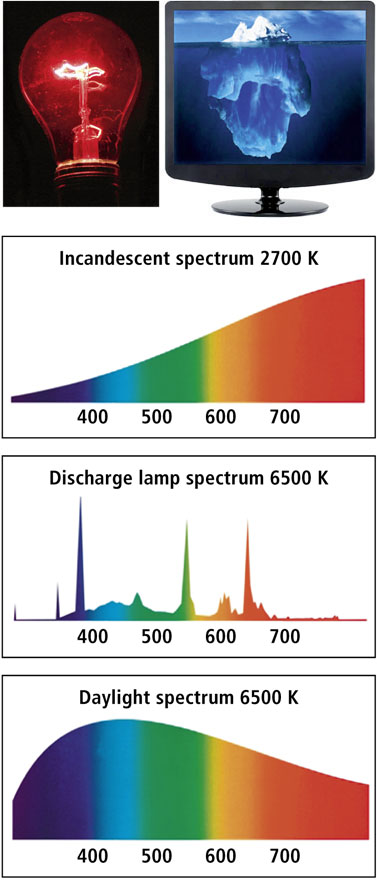Energy Saving Light Bulbs can make you ill!
Light therapist and physician Alexander Wunsch has spent years warning us of the danger of mercury emissions given off by energy saving light bulbs, LCD televisions and computer screens. In this interview he explains the many ways in which these fluorescent lights inflict damage on us.
Several new studies suggest a link between artificial light at night and hormone-related illnesses, above all cancer. The most recent comes from Israel and was even mentioned in the international press. Are the results in fact so surprising?
Alexander Wunsch: What is highly surprising is that this study has ascertained a markedly increased risk of prostate cancer in men – and previously an increased risk of breast cancer in women, although only outdoor light was measured. The lighting level inside our homes and offices, which affects us much more strongly, was not even considered. The study you mentioned is just the tip of the iceberg. New investigations have been submitted almost every year for two decades, which all point in the same direction.
You don’t hear much about this in the public domain.
Well, you only perceive what you know. Or to put it another way: we can only recognise and diagnose what we already know. The realisation that the wrong use of artificial light can have serious effects on our health would of course lead to the question of whether becoming a 24-hour society is at all desirable. For example, do I really need to fill up my tank at the petrol station, as well as buy groceries at the shop there at three o’clock in the morning? We willingly exploit the comforts of an industrialized world, but they frequently conflict with a natural and healthy way of life. The decision we make in this dilemma is left to our intellect, our rational thinking. That’s why cancer and most other diseases of civilization are so dangerous – because we don’t sense the illness slowly developing. There is a lack of timely warning signals from the body. High blood pressure, for example, doesn’t actually hurt. So intellect must take over the role that is otherwise played by pain.
So should we go to bed early and get up with the lark, like an old traditional proverb advises?

The reddish filament bulb and the blue-ish flatscreen light have very different spectra: incandescent (above), energy saving bulbs (centre), sunlight (below). The disharmonic spectrum of a discharge lamp clearly shows the mercury signature (left peak).
What do you mean by that?
Just imagine you tried to illuminate a room in the 18th century as strongly as you can do today simply by flicking a switch. It would quickly have become much too hot and you would have got a headache. That was actually the problem in early theatres: because of the burning light sources, many visitors quickly developed headaches or respiratory complaints. “Natural” artificial light, among which I also count gaslight and incandescent light bulbs in addition to candlelight, follows a natural radiation curve, the so-called Black Body Curve. All these light sources become unpleasant once they reach a certain brightness, be it through excessive smoke and heat, or the consumption of oxygen. At this point physical malaise clearly signals that a certain level is being exceeded.
However, with modern hormone-active artificial light, two different factors play a role: not just brightness, but also the proportion of blue light. All incandescent or burning light sources – i.e. incandescent bulbs – have a comparatively low to very low quantity of blue light.
Blue light makes you blind
Energy saving bulbs and fluorescent lamps in general radiate a light containing a much too high short-wave proportion of blue. This not only disrupts our hormone system, but also burns our eyes. “In a multiplicity of cell experiments it was ascertained that blue light damages the receptor cells of the retina oxidatively, and can spur on the development of age-related macular degeneration (AMD)”, explains light biologist Alexander Wunsch. This eye disease, to date incurable, involves a progressive destruction of the spot of the sharpest vision (the so-called macula lutea, also called the “yellow spot”) and mostly ends in blindness. At 50 percent, AMD is the most frequent cause for acquired blindness in Germany. One in three people aged over 65 today are already showing the first signs of macular degeneration.
In the macula lutea there are only very few receptors for short-wave light. This is filtered out by the eponymous yellow pigment lutein, which thus protects the spot of the sharpest vision. When artificial light is over-saturated with this aggressive blue, the filter pigment in the eye is unduly strained and sensory cells begin to die off. A gradual creeping blindness then sets in.
This happens very rapidly in rats. In animal experiments, the small rodents were radiated with normal fluorescent light, and damage to the retina was observed after just four days. After thirty days, the retinas of the animals were irreversibly damaged.
“For the retina, blue light is more dangerous than UV radiation, since the ultraviolet parts are already filtered out by the front sections of the eye, such as by the cornea and lens,” continues Alexander Wunsch. “Visible short-wave light on the other hand penetrates right up to the retina unhindered, and creates oxidative stress there.”Because the macula lutea, as the spot of the sharpest vision, predominantly contains receptors for green and red light, the short-wave blue impedes sharp vision. Similarly, intensive blue rarely occurs in Nature as a colour: sky and water almost always exhibit a highly moderated colour intensity. Moreover, the eye does not have to focus if we look at these two vast surfaces.
For this reason, traditional incandescent light supports sharp, high-contrast sight and protects the eye through its low proportion of short-wave radiation. Professor Karl Albert Fischer, leader of the Austrian Institute for Light and Colour, even believes: “Warm light from incandescent light bulbs, which is similar to sunlight in many respects, can take care of the retina according to the most recent studies.” A great number of scientific studies actually substantiate the idea that long-wave near infrared light, emitted to a large degree by incandescent light bulbs, quite clearly strengthens the resistance and ability to self-heal in cells.
An important reason for the emergence of hormone-dependent illnesses is actually the suppression of melatonin in the body. Blue light plays the most important role here. So why is melatonin so important?
In late 2008 two studies appeared in Japan, in each of which 30,000 men and women took part. Scientists concluded that even a hundred years ago people were subject to darkness for nine to ten hours a day, during which time the darkness hormone melatonin could be produced. Today it’s around six to seven hours. Less melatonin means, for example, less protection against free radicals, i.e. a higher risk of getting colon, prostate or breast cancer.
Because the body no longer rests enough?
Melatonin has various functions. With a foetus (which of course does not absorb any light in the womb through the eyes), the maternal melatonin synchronizes its organ clocks. Each person has a central clock in the interbrain (diencephalon), which creates the circadian rhythm of about 24 hours and transmits this to the body via the nervous and endocrine system. This main clock is linked to the retina of the eye via the so-called retinohypothalamic tract, so it receives its synchronization signal through the light that comes in through the eyes.
Melatonin in turn coordinates the clocks of the various organs. Each organ actually has its own cycle, and ideally all organ clocks run in synchrony with the central clock in the interbrain, like train station clocks. This is one of melatonin’s functions.
Throughout the day we are motor-active and spend more energy; during the night rest plays an important role. Melatonin enables regeneration at the most varied of levels, right up to the mitochondria in the cells.
Therefore fluorescent lamps are increasingly being replaced with yellow LED lights for nocturnal illumination in old people’s homes, because these disturb sleep less. This is particularly important for elderly people, whose circadian rhythms slacken in old age.
(...)
- Fluorescent light from energy saving bulbs and lamps, and from computer flatscreens and LCD/LED televisions radiate a much too high amount of blue light (this is why their light feels so “cold”).
- Blue light in the evening and during the night disrupts our hormone balance, as it suppresses the production of the ‘hormone of darkness’ melatonin. This can lead to sleeping problems, as well as encourage hormone-related illnesses such as cancer, as diverse studies have shown.
- Too much blue light burns certain sensory cells in the eye and reduces the retina’s natural ability to regenerate.
- Energy saving bulbs, computer TFT monitors and LCD televisions also emit a so-called mercury light, which contains intensive energy peaks of 436 nanometres. It is precisely this wavelength that can release cell-damaging materials in the body (particularly in the eye). Mercury light intensifies the toxic effect of mercury present in the body. Possible symptoms of poisoning are aggravated in this way.
- To protect yourself against harmful fluorescent light, you can wear special colour-tinted glasses, which filter out blue light and the dangerous mercury signature of 436 nanometres. These are highly suitable for working on the computer. You may order these filter glasses, which have been developed according to scientific criteria, at our ZeitenSchrift shop! (Get more infos about the special glasses by sending an email to: info@facts-are-facts.com)
- At home or in your private office, you should get rid of any form of fluorescent light and use exclusively incandescent bulbs. If you want to save lots of energy while completely eliminating electrosmog at the same time, this is best done with a low voltage halogen lamp, which must definitely be operated with a direct current.
- Education all the way: Tell your neighbours, work colleagues, friends and acquaintances. Put pressure on the authorities and politicians. There are more than enough facts by now.
There is also an online petition for keeping filament bulbs.







